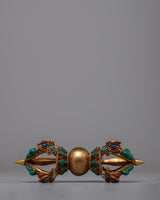
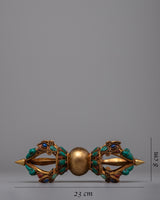
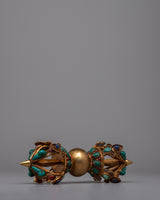
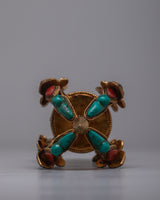
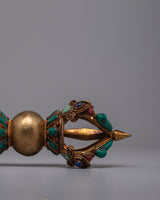
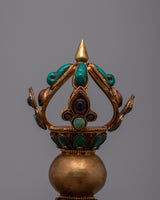

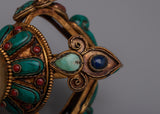
Copper Buddhist Vajra | Sacred Tool for Channeling Divine Energy and Blessings

100% AUTHENTIC

HANDMADE

FREE SHIPPING
Copper Buddhist Vajra
About Out Tibetan Vajra :
The Copper Buddhist Vajra, carefully made on a copper body with exceptional handmade workmanship, is a stunning emblem of spiritual power and enlightenment. Every element of this holy object showcases the care and artistry that went into making it. Its electro-gold and silver plating gives it a heavenly radiance that raises the level of respect for it.
When Original and Artificial lapis lazuli, turquoise, and coral are inlaid, the Vajra is transformed into an aesthetically pleasing and profoundly symbolic work of art. The purity, wisdom, and compassion these priceless stones represent increase the Vajra's effectiveness as a spiritual energy channel. Handmade Copper Buddhist Vajra, perfect for meditation or ceremonial use or just to be appreciated for its exquisite workmanship, is a potent reminder of the transformational power of devotion and faith.
Introduction to Vajra :
Vajra is a Sanskrit word meaning both thunderbolt and diamond. It is a weapon used as a ritual object to symbolize the properties of a diamond (indestructibility) and a thunderbolt (irresistible force). The five-pronged vajra is the most commonly seen vajra.
This Vajra is to be used during empowerment. Usually needs two Vajras, one for the Mandala tied to the Sung-Tak with five coloured cords and the second for the Vajra Master. Sanskrit word vajra or Dorje in Tibetan is defined as "diamond" or "adamantine." As such, the word vajra sometimes signifies enlightenment, or the absolute reality of shunyata, emptiness. Dorje offers protection and invokes blessings.
------------------------------------------
Size: 8 cm(Height) x 23 cm(Width)
Weight: 0.378 kg
Material: Copper Body, Electro Gold and Silver Plated, Original and Artificial Stones like Coral, Turquoise, and Lapis Lazuli
------------------------------------------
How to set up your own Buddhist Shrine?
-Find a clean, quiet, and uncluttered spot.
-Set up an altar table, and cover it with an altar cloth that calls to you.
-Place your sacred item (statue, thangka, or a picture of Buddha) at the centre.


















